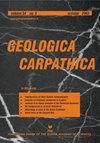斯洛伐克南部第三系玄武岩中斜辉石斑晶、巨晶和堆积的系统学及其岩石圈地幔结构的意义
IF 1.5
4区 地球科学
Q4 GEOSCIENCES, MULTIDISCIPLINARY
引用次数: 0
摘要
本文章由计算机程序翻译,如有差异,请以英文原文为准。
Systematics of clinopyroxene phenocrysts, megacrysts, and cumulates in Tertiary basalts of southern Slovakia with implications in the structure of lithospheric mantle
: Tertiary alkali basalts in the South-Slovakian Basin contain homogeneous clinopyroxene megacrysts, composite phenocrysts with chemically and optically homogeneous olive-green cores overgrown by oscillatory zoned rims, and fragments of clinopyroxene-rich igneous cumulates. Discrimination based on Ca, Na, Ti and Cr concentrations defined clinopyroxenes with alkalic, tholeiitic and transitional affinities. Single-pyroxene thermobarometry revealed that the incipient clinopyroxene crystallization occurred at 1300–1350 °C and 2.0–2.2 GPa, thus identifying the zone of mantle melting in a depth of >70 km. The highest frequency of pressure data from clinopyroxene-rich mafic cumulates, betwen 0.7 and 1.2 GPa, indicate stagnant basaltic reservoirs located beneath the Moho discontinuity, 30–43 km deep. Late fractionation products of alkali basalt derivatives may have occurred as laccoliths and dykes in the lower crust. Thermodynamic modelling of mineral assemblages of cumulate xenoliths revealed that parental melts for both alkalic and tholeiitic affinities were silica-undersaturated (46–46.5 wt. % SiO 2 ) and moderately alkalic (index of alkalinity 2.0–3.8, Mg# ~50) basalt to basanite, with pre-eruptive water contents between 1 and 2 wt. %. Amphibole–biotite– titanite–ilmenite–plagioclase cumulates recorded the advanced stage of fractionation of more calcic basalt at 900–920 °C and 0.65 GPa. Deep-seated basalt reservoirs have been less alkalic than erupted lavas, the latter showing a Mg depletion and an increasing aluminium saturation index diagnostic of the extensive crystal separation on the way to the surface. Olive-green megacrysts and cores of zoned phenocrysts originated at lower temperatures and higher pressures than their autocrystic rims. The megacrystic assemblage of Fe-diopside–Al-augite, Mg-calcite, apatite, ulvöspinel, and disintegrated amphibole crystallized from evolved, relatively cold (~950–1100 °C), Fe-rich carbonatite–alkalic silicate melt within the depth interval of 26–53 km, corresponding to a lithostatic pressure of 0.7–1.5 GPa. The silicate–carbonate–phosphate melt fraction probably originated in the subducting slab of oceanic crust.
求助全文
通过发布文献求助,成功后即可免费获取论文全文。
去求助
来源期刊

Geologica Carpathica
地学-地球科学综合
CiteScore
2.40
自引率
23.10%
发文量
26
审稿时长
>12 weeks
期刊介绍:
GEOLOGICA CARPATHICA covers a wide spectrum of geological disciplines including geodynamics, tectonics and structural geology, volcanology, stratigraphy, geochronology and isotopic geology, karstology, geochemistry, mineralogy, petrology, lithology and sedimentology, paleogeography, paleoecology, paleobiology and paleontology, paleomagnetism, magnetostratigraphy and other branches of applied geophysics, economic and environmental geology, experimental and theoretical geoscientific studies. Geologica Carpathica , with its 60 year old tradition, presents high-quality research papers devoted to all aspects not only of the Alpine-Carpathian-Balkanian geoscience but also with adjacent regions originated from the Mediterranean Tethys and its continental foreland. Geologica Carpathica is an Official Journal of the Carpathian-Balkan Geological Association.
 求助内容:
求助内容: 应助结果提醒方式:
应助结果提醒方式:


